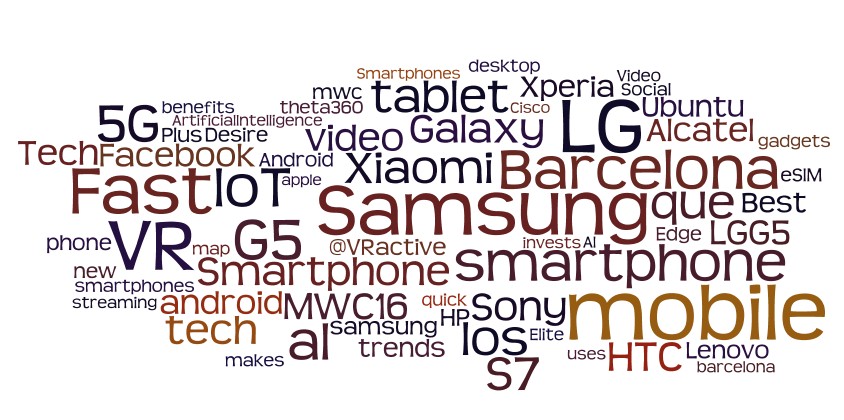More than 100,000 people descended upon Mobile World Congress (MWC) last week to watch experts from around the world discuss and share their views of what the future has in store for “mobile.”
After four days at the event, what became obvious to me is that we have certainly progressed from the days when a mobile phone was capable only of making calls, sending SMS messages, and playing the occasional game of Snake. The exhibition hall was packed full of companies showcasing the latest smartphone capabilities and Internet-connected devices that look to make mobile devices even more central to the way we live our lives. In fact, we can now use our phones to unlock car doors, control the heating in our homes, and monitor our health, all while on the move. What excited many industry experts, however, was virtual reality. It seems everyone was talking about it (as you can see from the word cloud, below). LG, HTC, and Facebook (to name just a few) made noise about their virtual reality products and Samsung even had its own virtual theater, allowing visitors to try their hands at snowboarding.
What was undoubtedly clear from MWC, then, is that future mobile technologies will go far beyond a smartphone. Companies, both well-known and those making a name for themselves, were keen to use the event to showcase just what experiences they are capable of delivering to their customers beyond a call, text, or casual Internet surf.
The networks supporting these devices, for example, was a much discussed topic, with 5G taking center stage. Although this side of MWC tends to slip under the radar, many industry experts believe the rise of the Internet of Things will truly be successful only with the introduction of 5G. As such, the work going into the building of networks that can support the connected world was a hotly discussed topic—showing the sheer scale to which this mobile ecosystem is growing.
Evidently from MWC, 2016 is going to be an exciting year for innovation in mobile—one that it is going to excite consumers and pave the way for the connected world. But for this to be a success, we need to first and foremost address security. We know that where consumers go, criminals go too. And we only have to look at the figures to see that they are going to mobile devices: Our latest Mobile Threat Report found that 37 million mobile malware have been detected during the last six months.
Of course, the criminals are not after the devices. They want the valuable data. Facebook’s Mark Zuckerberg said in his keynote said that virtual reality will provide another level of tailored and emotional connection for brands and consumers alike, given the huge amount of personal data collected on the headset. But what happens when this data falls into the wrong hands? Today, unfortunately, it’s not a question of “if” but “when.”
In a world of 5G hyperconnectivity, in which more data gathering and devices will become more ingrained in our personal and professional lives, trusting the access given to personal information will be crucial. We need to do more today to set the stage. We need to first get right the security basics and establish that foundation of trust so that companies can deliver on the promises we’ve seen at MWC.
The biggest trends of MWC 2016:












